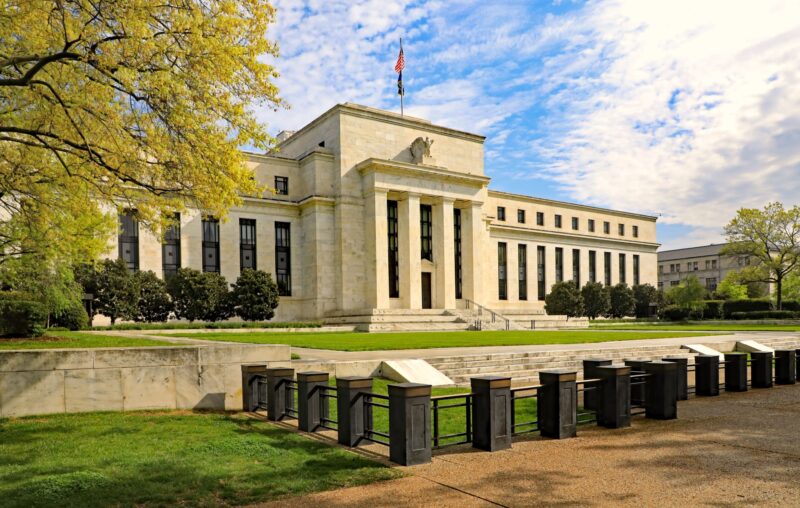
The Federal Reserve has a 2-percent inflation target. Central bankers are supposed to conduct monetary policy such that the long-run trajectory of the price level follows a 2-percent growth path. Most policy-focused macroeconomists think this is a reasonable way to achieve price stability and predictability without running the risk of deflation. But some economists want the Fed’s inflation target to be higher. They think something like a 4-percent inflation target would give the Fed more wiggle room to ease policy, should recessionary pressures emerge.
These economists are wrong. They misunderstand the nuances of monetary policy, as well as the basics of how the market price system works. There’s no good reason for the Fed to raise its inflation target. Competent economists should work to discredit this idea as quickly as possible.
Supporters of a higher inflation target claim that it would give the Fed some extra ammunition. The key is the link between interest rates and inflation. From the Fisher equation, we know that the nominal interest rate equals the real (inflation-adjusted) interest rate, plus anticipated inflation. In the long run, inflation usually doesn’t affect supply and demand in capital markets, so the only permanent effect of a higher inflation target is higher nominal rates. Suppose the equilibrium nominal interest rate under a 2-percent inflation target is 5 percent, implying a 3-percent real return with 2-percent anticipated inflation. If the Fed were to increase its inflation target to 4 percent, the equilibrium nominal interest rate would increase to 7 percent, with the real return unchanged.
Higher rates supposedly give the Fed more room to maneuver. To loosen monetary policy, modern central banks reduce their nominal interest rate target. But nominal rates can’t fall much below zero, since one can always hold cash to avoid a negative interest rate. Thus a bigger gap between the “effective lower bound” and the neutral policy rate (again, a nominal variable) means the Fed has a wider scope for stimulative policy.
Why not give the central bank a wider berth, if it helps to stabilize the economy? Because it doesn’t actually help. Interest rates are a distraction. To loosen monetary policy, the Fed must boost nominal spending. It can do that even if interest rates are at the effective lower bound. Furthermore, inflation doesn’t help the economy. It’s really a drag on the economy.
As I’ve written before, the Fed can’t control the real interest rate. The most it can do is help the economy adjust from one real interest rate to another as economic fundamentals change. In the wake of a recession, interest rates usually fall. The Fed’s job is to nudge dollar-denominated variables in the right direction. Monetary policy is much more like recalibrating the economy’s barometer than flooring the economy’s gas pedal.
Of course, expansionary policy (printing money to purchase securities) can help fight recessions. But the reason isn’t that interest rates are lower. Rather, it’s that the Fed, as the monopoly supplier of high-powered money, can provide the needed liquidity when the economy faces an aggregate demand shortfall. It’s proper to grow the money supply in response to a sudden and unexpected increase in money demand. The textbook effects on interest rates are downstream from this fundamental task.
When we stop thinking in terms of interest rates and start thinking in terms of the supply of and demand for money, we see that there’s nothing special about a 2-percent inflation target. The Fed’s goal is based on consensus and compromise, not any hard and fast rule about how markets work. Remember the dynamic version of the equation of exchange: effective money supply growth must equal total nominal spending growth. Provided market expectations mesh with actual Fed behavior, we can have a full employment equilibrium at 2-percent inflation, 4-percent inflation, or even 0-percent inflation. What matters is the credibility and predictability of policy.
So what’s wrong with higher inflation? In brief, full-employment equilibria are not created equal. High rates of inflation reduce productivity, which means we produce fewer goods and services than we would at a lower rate of inflation.
Inflation throws a wrench in the economy’s gears. Markets are good at creating wealth when prices correctly signal relative resource scarcities. But market prices are denominated in money. Tinkering with money introduces noise in the pricing process. While it’s theoretically possible to have a high, but perfectly neutral, inflation rate, meaning there are no effects of inflation on relative prices, in practice this never happens. More inflation means more variability in how monetary policy affects supply and demand in particular markets. Faster price-level growth almost certainly weakens the market allocation process.
Furthermore, market actors often engage in privately beneficial, but socially costly, behaviors to avoid the effects of inflation. A weakening dollar is a tax on holding cash and other highly liquid assets. The obvious incentive is to economize on these assets as much as possible. But that makes transacting more difficult than it otherwise would be. Likewise, higher inflation rates encourage more frequent contracting, which increases uncertainty as well as the cost of contracting. Inflation is an underappreciated source of transaction costs.
Finally, although I previously wrote that inflation doesn’t usually affect supply and demand in capital markets, there is an important exception: in the US, capital gains taxes are not indexed to inflation. Since asset prices tend to rise when all other prices are rising, inflation pushes investors into higher tax brackets. They forfeit more wealth to the government despite the fact that, in terms of real resources, their portfolios have not appreciated. This is a major disincentive to save and invest, and hence a drag on economic growth.
The campaign for the Fed to adopt a higher inflation target makes no sense. It’s not supported by policy best practices, or by basic economic theory. Instead, it’s a symptom of the “Great Forgetting” currently plaguing the economics profession. Let’s hope we can put a lid on this misguided idea before it does any real harm.
